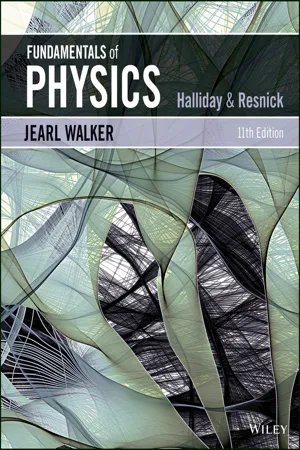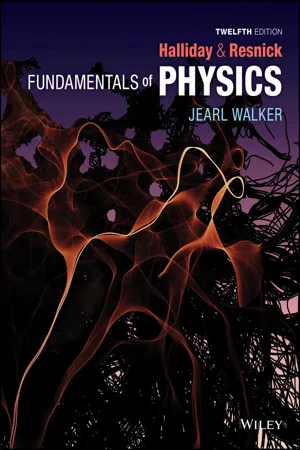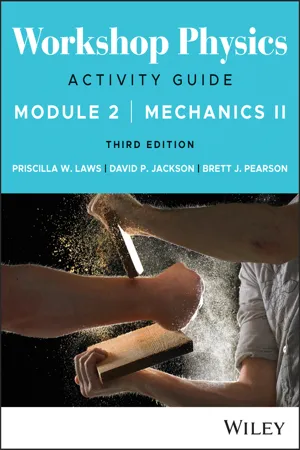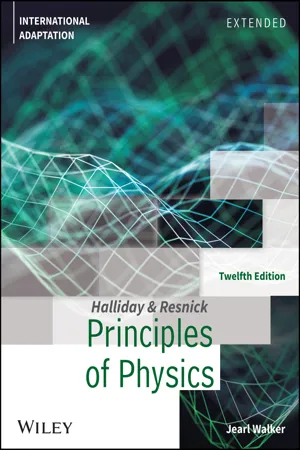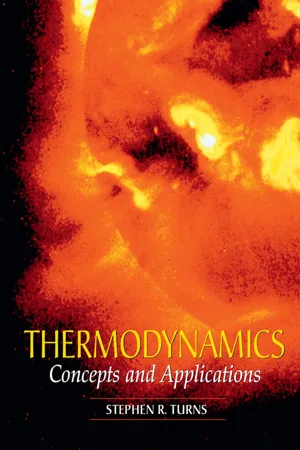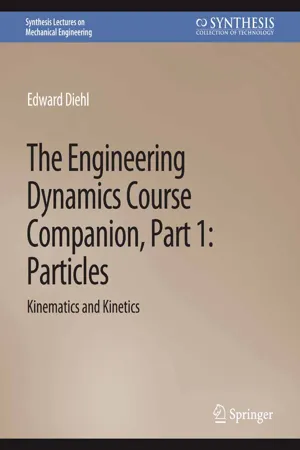Mathematics
Conservation of Mechanical Energy
The conservation of mechanical energy states that in a system where only conservative forces are acting, the total mechanical energy (the sum of kinetic and potential energy) remains constant over time. This principle is derived from the work-energy theorem and is a fundamental concept in physics, often used to analyze the motion of objects and systems.
Written by Perlego with AI-assistance
Related key terms
1 of 5
10 Key excerpts on "Conservation of Mechanical Energy"
- eBook - PDF
- David Halliday, Robert Resnick, Jearl Walker(Authors)
- 2020(Publication Date)
- Wiley(Publisher)
If only conservative forces do work within an isolated system, then the mechanical energy E mec of the system cannot change. This principle of Conservation of Mechanical Energy is written as K 2 + U 2 = K 1 + U 1 , in which the subscripts refer to different instants during an energy transfer process. This conservation principle can also be written as ∆E mec = ∆K + ∆U = 0. ©AP/Wide World Photos In olden days, a person would be tossed via a blanket to be able to see farther over the flat terrain. Nowadays, it is done just for fun. During the ascent of the person in the photograph, energy is transferred from kinetic energy to gravi- tational potential energy. The maximum height is reached when that transfer is complete. Then the transfer is reversed during the fall. 157 8-2 Conservation of Mechanical Energy when the system is isolated and only conservative forces act on the objects in the system. In other words: This result is called the principle of Conservation of Mechanical Energy. (Now you can see where conservative forces got their name.) With the aid of Eq. 8-15, we can write this principle in one more form, as ∆E mec = ∆K + ∆U = 0. (8-18) The principle of Conservation of Mechanical Energy allows us to solve problems that would be quite difficult to solve using only Newton’s laws: Figure 8-7 A pendulum, with its mass concentrated in a bob at the lower end, swings back and forth. One full cycle of the motion is shown. During the cycle the values of the potential and kinetic ener- gies of the pendulum – Earth system vary as the bob rises and falls, but the mechani- cal energy E mec of the system remains constant. The energy E mec can be described as continuously shifting between the kinetic and potential forms. In stages (a) and (e), all the energy is kinetic energy. The bob then has its greatest speed and is at its lowest point. In stages (c) and (g), all the energy is potential energy. The bob then has zero speed and is at its highest point. - eBook - PDF
- David Halliday, Robert Resnick, Jearl Walker(Authors)
- 2018(Publication Date)
- Wiley(Publisher)
Thus, we have only a conservative force doing work in an isolated system, so we can use the principle of conserva- tion of mechanical energy. Calculations: Let the mechanical energy be E mec,t when the child is at the top of the slide and E mec,b when she is at the bottom. Then the conservation principle tells us E mec,b = E mec,t . (8-19) Sample Problem 8.03 Conservation of Mechanical Energy, water slide The huge advantage of using the conservation of energy instead of Newton’s laws of motion is that we can jump from the initial state to the final state without considering all the intermediate motion. Here is an example. In Fig. 8-8, a child of mass m is released from rest at the top of a water slide, at height h = 8.5 m above the bottom of the slide. Assum- ing that the slide is frictionless because of the water on it, find the child’s speed at the bottom of the slide. KEY IDEAS (1) We cannot find her speed at the bottom by using her acceleration along the slide as we might have in earlier chapters because we do not know the slope (angle) of the slide. However, because that speed is related to her kinetic energy, perhaps we can use the principle of Conservation of Mechanical Energy to get the speed. Then we would not need to know the slope. (2) Mechanical energy is conserved in a system if the system is isolated and if only conservative forces cause energy transfers within it. Let’s check. Forces: Two forces act on the child. The gravitational force, a conservative force, does work on her. The normal force on her from the slide does no work because its direc- tion at any point during the descent is always perpendicular to the direction in which the child moves. Figure 8-8 A child slides down a water slide as she descends a height h. h The total mechanical energy at the top is equal to the total at the bottom. Reading a Potential Energy Curve Once again we consider a particle that is part of a system in which a conservative force acts. - eBook - PDF
- David Halliday, Robert Resnick, Jearl Walker(Authors)
- 2021(Publication Date)
- Wiley(Publisher)
Included in ∆E mec are changes ∆K in kinetic energy and changes ∆U in potential energy (elastic, gravitational, or any other type we might find). This law of conservation of energy is not something we have derived from basic physics principles. Rather, it is a law based on countless experiments. Scientists and engineers have never found an exception to it. Energy simply can- not magically appear or disappear. Isolated System If a system is isolated from its environment, there can be no energy transfers to or from it. For that case, the law of conservation of energy states: The total energy E of an isolated system cannot change. In an isolated system, we can relate the total energy at one instant to the total energy at another instant without considering the energies at intermediate times. ∆E mec + ∆E th + ∆E int = 0 (isolated system). (8.5.2) We can also let ∆E mec = E mec,2 − E mec,1 , where the subscripts 1 and 2 refer to two different instants—say, before and after a certain process has occurred. Then Eq. 8.5.2 becomes E mec,2 = E mec,1 − ∆E th − ∆E int . (8.5.3) Equation 8.5.3 tells us: Figure 8.5.1 To descend, the rock climber must transfer energy from the gravitational potential energy of a system consisting of him, his gear, and Earth. He has wrapped the rope around metal rings so that the rope rubs against the rings. This allows most of the transferred energy to go to the thermal energy of the rope and rings rather than to his kinetic energy. This fact can be a very powerful tool in solving problems about isolated systems when you need to relate energies of a system before and after a certain process occurs in the system. In Module 8.2, we discussed a special situation for isolated systems—namely, the situation in which nonconservative forces (such as a kinetic frictional force) Many energy transfers may be going on within an isolated system—between, say, kinetic energy and a potential energy or between kinetic energy and ther- mal energy. - eBook - PDF
Workshop Physics Activity Guide Module 2
Mechanics II
- Priscilla W. Laws, David P. Jackson, Brett J. Pearson(Authors)
- 2023(Publication Date)
- Wiley(Publisher)
8 Extending Mechanical Energy Conservation With the addition of the spring force, we now have three terms in our expression for mechanical energy E mech = K + U g + U s (11.15) where K is the kinetic energy of the system, U g is the gravitational potential energy of the system, and U s is the spring (or elastic) potential energy of the system. As long as there are no non-conservative forces acting and the net exter- nal work on the system is zero, we know that the mechanical energy of the system will be conserved. Thus, as long as air resistance and friction can be neglected, we can solve a variety of problems incorporating both gravitational and spring forces. 7 Recall that it is only the change in the potential energy function that is physically meaningful. Therefore, potential energy functions are only defined up to an arbitrary constant. 8 Clearly, any real spring will have some mass and will therefore have some kinetic energy. The ideal spring approximation assumes that the kinetic energy of the spring is small in comparison to the total mechanical energy of the system. 366 WORKSHOP PHYSICS ACTIVITY GUIDE 11.5.2. Activity: A Mass Hanging from a Spring a. Imagine a spring with spring constant k and relaxed length hangs from the ceiling. An object of mass m is connected to the spring and released from this initial position with zero velocity. A convenient coordinate system for this problem is to choose the y-axis pointing vertically upward, with y = 0 located where the mass is initially released (the equilibrium position of the spring). Using this coordinate system determine the initial kinetic energy, the initial gravitational potential energy, and the initial spring potential energy for this problem. Then write down the total mechanical energy of the system at this initial position. y-axis y = 0 b. After being released from its initial position, the object will initially speed up as it begins moving down. - eBook - PDF
- John Botsis et Michel Deville(Author)
- 2018(Publication Date)
- PPUR(Publisher)
Chapter 4 Energy 4.1 Introduction Having described the principles of conservation of mass, momentum, and an- gular momentum, we will now introduce the principles related to the thermo- dynamics of continuous media in motion and the conservation of energy. We can recall that all deformations in a material produce a thermal effect in the same way that a thermal effect produces a deformation. This is easily observed by heating a metal bar which lengthens under the action of the heat. In this chapter, we will generally work in the spatial or Eulerian represen- tation. The principle of conservation of total energy is first established. It leads to the principle of conservation of internal energy. Then, we will con- sider the Conservation of Mechanical Energy in the Lagragian representation. Later, we will show that from the principle of conservation of total energy, for which objectivity is imposed, we can infer the other conservation laws. Finally, the chapter ends with the introduction of entropy and the second law of ther- modynamics, which is based on the Clausius–Duhem inequality, a measure of the irreversibility of the phenomena associated with the physics of continuous media. Continuous media thermodynamics is covered in detail by the following authors: [15, 17, 18, 22, 58, 68]. 4.2 Conservation of Energy Let ω(t) be the material volume of a continuous medium at the instant t, such that ω(t) ⊆ R, the deformed configuration of the body B. We generalize the concept of kinetic energy by defining it as the integral over the deformed volume ω(t) of half the density, ρ(x, t), multiplied by the square of the local spatial velocity, v(x, t). The kinetic energy of ω(t), which we denote E k (t), is a scalar given by the relation E k (t) = Z ω(t) ρ(x, t) v(x, t) · v(x, t) 2 dv . (4.1) 142 Energy To simplify, the dependence of ω with respect to time will no longer be explic- itly shown in the following. - David Halliday, Robert Resnick, Jearl Walker(Authors)
- 2023(Publication Date)
- Wiley(Publisher)
(8.1.9) Elastic Potential Energy Elastic potential energy is the energy associated with the state of compression or extension of an elastic object. For a spring that exerts a spring force F = −kx when its free end has displacement x, the elastic potential energy is U(x) = 1 _ 2 kx 2 . (8.1.11) REVIEW & SUMMARY The reference configuration has the spring at its relaxed length, at which x = 0 and U = 0. Mechanical Energy The mechanical energy E mec of a system is the sum of its kinetic energy K and potential energy U: E mec = K + U. (8.2.1) An isolated system is one in which no external force causes energy changes. If only conservative forces do work within an isolated system, then the mechanical energy E mec of the system cannot change. This principle of Conservation of Mechanical Energy is written as K 2 + U 2 = K 1 + U 1 , (8.2.6) in which the subscripts refer to different instants during an energy transfer process. This conservation principle can also be written as ∆E mec = ∆K + ∆U = 0. (8.2.7) Potential Energy Curves If we know the potential energy function U(x) for a system in which a one-dimensional force F(x) acts on a particle, we can find the force as F(x) = − dU(x) _ dx . (8.3.2) If U(x) is given on a graph, then at any value of x, the force F(x) is the negative of the slope of the curve there and the kinetic energy of the particle is given by K(x) = E mec − U(x), (8.3.4) where E mec is the mechanical energy of the system. A turning point is a point x at which the particle reverses its motion (there, K = 0). The particle is in equilibrium at points where the slope of the U(x) curve is zero (there, F(x) = 0). Work Done on a System by an External Force Work W is energy transferred to or from a system by means of an external force acting on the system. When more than one force acts on 200 CHAPTER 8 Potential Energy and Conservation of Energy a system, their net work is the transferred energy.- Raymond Serway, John Jewett(Authors)
- 2018(Publication Date)
- Cengage Learning EMEA(Publisher)
Isolated System (Energy). The total energy of an iso- lated system is conserved, so DE system 5 0 (8.10) If no nonconservative forces act within the isolated system, the mechanical energy of the system is con- served, so DE mech 5 0 (8.7) which can be written as DK 1 DU 5 0 (8.5) If a nonconservative force such as friction acts within the system, there is a change in internal energy, so DK 1 DU 1 DE int 5 0 (8.16) Work Heat Mechanical waves Matter transfer Electrical transmission Electromagnetic radiation Kinetic energy Potential energy Internal energy System boundary The change in the total amount of energy in the system is equal to the total amount of energy that crosses the boundary of the system. Kinetic energy Potential energy Internal energy System boundary The total amount of energy in the system is constant. Energy transforms among the three possible types. Summary 203 Copyright 2019 Cengage Learning. All Rights Reserved. May not be copied, scanned, or duplicated, in whole or in part. Due to electronic rights, some third party content may be suppressed from the eBook and/or eChapter(s). Editorial review has deemed that any suppressed content does not materially affect the overall learning experience. Cengage Learning reserves the right to remove additional content at any time if subsequent rights restrictions require it. 204 Chapter 8 Conservation of Energy Think–Pair–Share See the Preface for an explanation of the icons used in this problems set. For additional assessment items for this section, go to 1. You are a member of an expert witness group that provides scientific services to the legal community. Your group has been asked by a defense attorney to prove at trial that a driver was not exceeding the speed limit. You are provided with the following data: The mass of the car is 1.50 3 10 3 kg. The mass of the driver is 95.0 kg. The coefficient of kinetic friction between the car’s tires and the roadway is 0.580.- eBook - PDF
Thermodynamics
Concepts and Applications
- Stephen R. Turns(Author)
- 2006(Publication Date)
- Cambridge University Press(Publisher)
(See Ref. [4].) Rudolf Clausius (1822–1888) wrote in 1850 one of the most succinct and modern-sounding statement of the energy conservation principle [6]: “The energy of the universe is constant.” (Clausius also named the property entropy and presented clear statements of the second law of thermodynamics. We will consider these concepts in Chapter 6.) 5.2 ENERGY CONSERVATION FOR A SYSTEM We begin our study of the conservation of energy principle by considering a system of fixed mass. We start by explicitly transforming the generic conservation principles from Chapter 1 (Eqs. 1.1 and 1.2) to statements of energy conservation. By defining X to be energy E, Eq. 1.1, which applies to the time interval t 2 t 1 , becomes E in E out E generated E stored E sys (t 2 ) E sys (t 1 ). (5.1) Similarly, by defining to be the time rate of energy Eq. 1.2, which applies to an instant, becomes (5.2) Figure 5.1 shows a system with superimposed arrows representing the various terms in these equations. Our task now is to associate each term in these conservation of energy equations with particular forms of energy for various physical situations. We consider rather general statements of energy conservation in which all forms of energy and their interconversions are allowed. Since we include all forms of energy in our energy accounting, no generation term appears. Our only restriction is the exclusion of nuclear transformations; the proper treatment of nuclear transformations and the relationship between mass and energy are beyond the scope of this book. E # stored . E # generated E # out E # in E # , X # At this point, you may find it useful to review the detailed discussion of systems and control volumes in Chapter 1. - eBook - PDF
- John D. Cutnell, Kenneth W. Johnson, David Young, Shane Stadler(Authors)
- 2018(Publication Date)
- Wiley(Publisher)
144 LEARNING OBJECTIVES After reading this module, you should be able to... 6.1 Determine the work done by a constant force. 6.2 Relate work and kinetic energy. 6.3 Use gravitational potential energy. 6.4 Identify conservative and nonconservative forces. 6.5 Use the law of Conservation of Mechanical Energy. 6.6 Solve problems involving nonconservative forces. 6.7 Solve problems involving power. 6.8 Employ the law of conservation of energy. 6.9 Determine the work done by a variable force. © Oleksiy Maksymenko Photography/Alamy CHAPTER 6 Work and Energy On the popular Behemoth roller coaster at Canada’s Wonderland amusement park, riders cresting the top of the hill will pick up speed on the way down, as they convert gravitational potential energy into kinetic energy. This conversion is governed by the principle of conservation of energy, a central topic in this chapter. 6.1 Work Done by a Constant Force Work is a familiar concept. For example, it takes work to push a stalled car. In fact, more work is done when the pushing force is greater or when the displacement of the car is greater. Force and displacement are, in fact, the two essential elements of work, as Figure 6.1 illustrates. The drawing shows a constant pushing force F → that points in the same direction as the resulting displacement s → .* In such a case, the work W is defined as the magnitude F of the force times the magnitude s of the displacement: W = Fs. The work done to push a car is the same whether the car is moved north to south or east to west, provided that the amount of force used and the distance moved are the same. Since work does not convey directional information, it is a scalar quantity. The equation W = Fs indicates that the unit of work is the unit of force times the unit of distance, or the newton · meter in SI units. One newton · meter is referred to *When discussing work, it is customary to use the symbol s → for the displacement, rather than x → or y → . - eBook - PDF
The Engineering Dynamics Course Companion, Part 1
ParticlesKinematics and Kinetics
- Edward Diehl(Author)
- 2022(Publication Date)
- Springer(Publisher)
129 C L A S S 8 Work-Energy Method and the Conservation of Energy (Part 1) B.L.U.F. (Bottom Line Up Front) • Work-Energy: KE 1 C PE 1 C U 1!2 D KE 2 C PE 2 . • Work: U 1!2 D R 2 1 F d r. • Kinetic Energy: KE D 1 2 mv 2 . • Gravitational Potential Energy: PE g D mgy D Wy . • Spring Potential Energy: PE sp D 1 2 kı 2 . • Conservation of Energy: KE 1 C PE 1 D KE 2 C PE 2 . 8.1 WORK-ENERGY EQUATION One of the most famous anecdotes in the history of science tells of young Sir Isaac Newton being struck on the head while sitting beneath an apple tree. This accident supposedly lead him to “discover gravity.” Gravity, of course, was already known to exist, but the event actually did occur and lead Newton to ponder the nature of gravity. The cartoon depiction in Figure 8.1 of this historical event highlights the essentials of the topics covered in this class: changing forms of energy. In this case the apple starts off with potential energy (PE) which is converted into kinetic energy (KE) as it drops toward Newtdog’s head. The complete equation we’ll use is presented below, and the individual parts are described in the following sections: KE 1 C PE 1 C U 1!2 D KE 2 C PE 2 ; 130 8. WORK-ENERGY METHOD AND THE CONSERVATION OF ENERGY (PART 1) PE KE Figure 8.1: Newtdog discovers gravity as Potential Energy (PE) is converted into Kinetic Energy (KE) (©E. Diehl). where KE 1 D Kinetic Energy at state 1 PE 1 D Potential Energy at state 1 U 1!2 D External Work acting on system between states 1 and 2 KE 2 D Kinetic Energy at state 2 PE 2 D Potential Energy at state 2 The Work-Energy equation might seem familiar to students who have taken or are taking Fluid Mechanics or Thermodynamics. You can think of this as the solid mechanics form of energy accounting.
Index pages curate the most relevant extracts from our library of academic textbooks. They’ve been created using an in-house natural language model (NLM), each adding context and meaning to key research topics.

